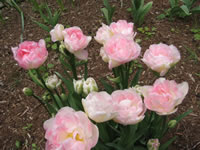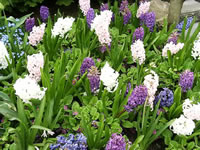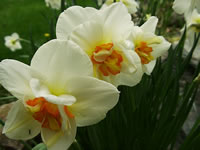An Introduction to Growing Bulb Type Plants
Bulbs, Corms, Rhizomes and Tubers
The terms "bulb" and "bulbous" are often used to describe any number of plantsthat grow from a swoolen or thick basal growth.
Only about a half of all bulbous plants are actually true bulbs.
The remainder of them are corms, rhizomes or tubers.
Bulbs, corms, rhizomes and tubers are all storage units for food that gives the plant the energy it needs to grow and bloom.

|
True Bulbs are the thickened underground storage organ of the group of perennials which includes Daffodils, Tulips, Lilies, Narcissus and Amaryllis. Bulbs grow in layers, like an onion. At the very heart of the bulb is a miniature version of the flower. Corms are thick underground stems which produce the new roots, leaves and flowers during each growing season. Corms look a lot like bulbs on the outside but corms do not grow in layers. They act as the base and food source for the flower stem. As the flower grows, the corm is used up and shrivels away. Before dying the corm will produce new baby corms. This group includes Crocus, Gladiolus and Tuberous Begonias Rhizomes are modified plant stems that grow horizontally under the surface of the soil. New growth then emerges from different points of the rhizome. They will continue to grow and creep along under the surface producing lots of growing points. Calla Liles, Canna, Bearded Iris and Water Lilies all grow from rhizomes. Tubers are flat underground stems which have a tough leathery skin and several eyes which are the growing points where the plants will emerge. This group includes Dahlias, Begonias, Caladiums and Anemones. |
Create A Flower Show with Bulbs
Spring flowering bulbs are available in such a variety of colors and blooming times that you can treat yourselfto continuous color and changing color schemes from late winter to early summer.
If your intent is only to drop a package of Daffodils into the ground,
then your planning will only involve 'where' you are going to set the bulbs.
However, if you'd like to create an extended flower show, you will need to do some research
into the plant heights and blooming times.
When Bulbs Bloom
Generally, the earliest flowers to bloom in the spring will be the Crocus and Snowdrops followed by Daffodils and Tulips.Before the spring bulb season is over, the Dutch Iris and Spanish Bluebells will grace your garden.
Within each of these groups, and all of the other spring bloomers, you will find a multitude
of hybrids which bloom at different times (i.e. early April, mid April, late April).
Use these hybrids to spread out the bloom time for each group, and you can enjoy each species for a much longer time.
As the last of the spring flowers fade away the early summer bloomers like the Star of Bethlehem will begin to flower.
There are many bulb type plants that bloom throughout the summer.
Cyclamen, Autumn Crocus and Fairy Lilies bloom well into the fall.
Snowdrops end or begin the year of bulb blooms in late winter.
Staging your Bulbs
The 'staging' of the planting area is of vital importance.Check the plant height on the package, and plant low-growing bulbs in front of taller ones,
based on where you will be viewing them the most often.
Think about your color scheme as you draw your map.
Contrasting colors make a great display, or you may want to use many hues of the same color.
Using white flowering bulbs will brighten even the plainest corner of the garden.
Many gardeners consider it a no-no to plant bulbs in a single straight line.
Personally, I feel that there are places and situations where this is quite appropriate,
but I use a 'modified' straight line (double line), offsetting each second bulb by an inch or two.
This gives the 'line' a little more stability against winds.
Bulb Growing Tips
|
Always buy top quality, firm, healthy bulbs! Avoid so called bargain bin bulbs. Inspect them carefully for blemishes and soft spots. The sooner you plant your bulbs after purchasing... the better! Many bulbs can be forced into bloom by planting them in pots, and growing them indoors. Most spring flowering bulbs require 12 to 14 weeks of temperatures below 40 degrees during the winter, which is why they are planted in the fall.
If you live in a climate that doesn't have this cold spell, you'll need to pre-chill certain bulbs before planting them. In severely cold climates, or in light sandy soil, bulbs should be planted 1" to 2" deeper. |
|
After that, it's important to feed the bulbs annually with a good bulb fertilizer
so that they can continue blooming in future seasons.
Allow the foliage to continue to grow after the spent flower spike has been removed until it dies back naturally!
If space is limited, bulbs can be planted in layers.
Dig a hole deep enough to accommodate the largest bulbs (Daffodils and Hyacinths).
Cover them with soil and plant a layer of tulips.
Cover the Tulips and plant a layer crocus or other small bulbs on top.
You can protect your bulbs from marauding rodents by lining the planting hole with 1/2 inch (or smaller) mesh chicken wire.
 |
 |
 |